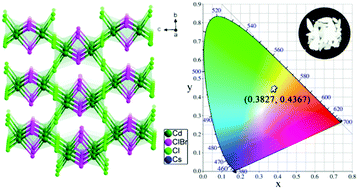Three-dimensional all-inorganic dual halogen emitter Cs2Cd2BrCl5 exhibiting broadband white-light emission†
Abstract
Single-component white-light-emitting materials have received increasing attention due to their excellent luminescence properties. Herein, a novel all-inorganic dual halogen emitter Cs2Cd2BrCl5 was successfully synthesized, which features a three-dimensional (3D) network structure. A series of photophysical characterizations show that Cs2Cd2BrCl5 exhibits broadband white-light emission at room temperature with a correlated color temperature (CCT) of 4286 K, a color rendering index (CRI) of 84.6 and a high photoluminescence quantum yield (PLQY) of 20.49%. Temperature-dependent emission spectra, structural distortion analysis of the CdCl3(Br/Cl)3 octahedron, and DFT calculation reveal that the broadband white-light emission of Cs2Cd2BrCl5 originates from self-trapped excitons (STEs). Importantly, Cs2Cd2BrCl5 shows splendid structural and optical stability, which makes it a potential candidate for light-emitting diodes (LEDs). To our knowledge, it is the first example of white-light emission in 3D Cd-based all-inorganic halide materials, which could provide new insight for the further design and synthesis of all-inorganic single-component white-light emitters.

- This article is part of the themed collection: Journal of Materials Chemistry C Emerging Investigators


 Please wait while we load your content...
Please wait while we load your content...